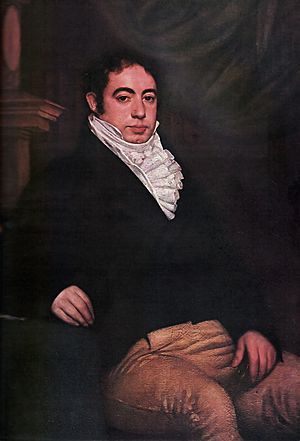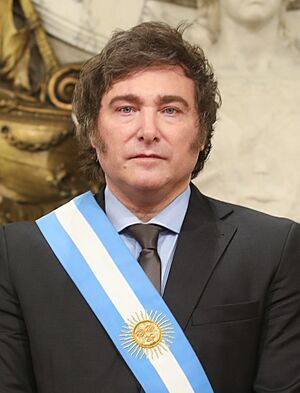President of Argentina facts for kids
Quick facts for kids President of the Argentine Nation |
|
|---|---|

Presidential standard
|
|
| Executive branch of the Government of Argentina | |
| Style | The Most Excellent |
| Residence | Quinta presidencial de Olivos (official residence) Chapadmalal Residence (summer house) Casa Rosada (government office) |
| Appointer | Direct popular vote or succession from the vice presidency |
| Term length | Four years
renewable once consecutively
|
| Constituting instrument | Constitution of Argentina (1853) |
| Formation | February 8, 1826 |
| First holder | Bernardino Rivadavia |
| Deputy | Vice President |
| Salary | ARS 2,156,418.21 (US$8,262) monthly (as of June 2023) |
The president of Argentina is the leader of the country. This person is officially called the president of the Argentine Nation. They act as both the head of state and the head of government for Argentina. The president is also the main leader of the federal government and the commander-in-chief of the country's armed forces.
Throughout Argentina's history, the role of the head of state has changed a lot. This includes its name, duties, and powers. The current president, Javier Milei, started his term on December 10, 2023. He took over from Alberto Fernández.
The Argentine Constitution sets out the rules for the president. It explains what is needed to become president, what powers they have, their responsibilities, how long they serve, and how they are elected.
Contents
History of the Presidency
Early Leaders of Argentina
Argentina's journey to becoming a nation began in 1776. At that time, the King of Spain, Charles III of Spain, created the Viceroyalty of the Río de la Plata. The king was still the head of state, but a local leader called a viceroy represented him. These viceroys were rarely from Argentina itself.
In May 1810, the May Revolution happened. This led to the formation of Argentina's first self-governing body, the Primera Junta, in Buenos Aires. Later, it became the Junta Grande when representatives from other areas joined. Even though these early groups had presidents, the King of Spain was still seen as the main head of state.

First Presidents and Constitutions
The idea of a single person holding executive power came with the creation of the supreme director role in 1813. In 1817, Argentina declared independence. A new constitution was written, giving the supreme director presidential powers. However, this constitution was never fully used.
A new constitution was created in 1826. This was the first time the title of "president" was used. Bernardino Rivadavia became Argentina's first president under this constitution. But due to a war, Rivadavia resigned, and the office was soon ended.
Unification and Modern Presidency
For many years, Argentina faced civil war between different groups. There was no strong central government. The governor of Buenos Aires often handled foreign relations. Juan Manuel de Rosas was one such governor who gained a lot of power over the country.
In 1852, Rosas was removed from power. A new constitution was then written, which is still largely in use today. This constitution created a national federal government with a president. The first president elected under this constitution was Justo José de Urquiza. However, Buenos Aires separated for a while. Bartolomé Mitre became the first president of the unified country when Buenos Aires rejoined.
Because of these changes, different historians consider Rivadavia, Urquiza, or Mitre as the "first" president of Argentina. Rivadavia was the first to use the title. Urquiza was the first under the 1853 Constitution. Mitre was the first president of the unified Argentina within its current borders.
Military Rule and Democracy
Several times in Argentina's history, elected presidents were removed by military coups. This happened in 1930, 1943, 1955, 1962, 1966, and 1976. Sometimes, a military leader took the title of president. Other times, a group of military leaders shared power.
Today, the Argentine government does not consider some of these military leaders, like Jorge Rafael Videla and Leopoldo Fortunato Galtieri, to be legitimate presidents. They were even denied presidential benefits after their time in power.
Presidential Powers and Duties
The president of Argentina has important powers given by the Constitution (Article 99):
- The president is the supreme leader of the nation and the head of government. They are responsible for how the country is run.
- They issue rules and instructions to make sure laws are followed.
- The president helps create laws, officially approves them, and makes sure they are published.
- They appoint judges for the Supreme Court and other federal courts. The Senate must approve these appointments.
- The president can grant pardons or reduce sentences for federal crimes.
- They appoint and remove ambassadors and other government ministers.
- The president is the top leader of all the nation's armed forces.
- Each year, the president speaks to Congress about the state of the nation.
- They can call special meetings of Congress if needed.
- The president oversees how the country's money is collected and spent.
- By tradition, the president is the godfather of the seventh son or seventh daughter in a family. This tradition became law in 1974.
How to Become President
Requirements for Office
To become president or vice president of Argentina, a person must meet certain requirements:
- They must have been born in Argentina, or be the child of an Argentine citizen born in another country.
- They must also meet the same requirements as a senator.
- To be a senator, a person must be at least 30 years old. They must have been an Argentine citizen for six years. They also need to be from the province they represent or have lived there for two years.
How Elections Work
Argentina uses a special election system called a two-round system or ballotage. To win in the first round, a candidate needs:
- More than 45 percent of the "positive votes" (valid votes for any candidate).
- OR at least 40 percent of positive votes AND be more than 10 percentage points ahead of the next candidate.
If no candidate wins in the first round, the top two candidates compete in a second round. This second round happens two weeks later. The candidate with the most votes in this round becomes president.
Term Length and Reelection
Since 1994, the president serves for four years. They can be reelected immediately for one more term. After serving two terms in a row, a president can run again after waiting one term. There is no limit to how many times a person can seek the presidency if they are not successful. The same rules apply to the vice president.
Before 1994, presidents served for six years and could not be reelected right away. For a short time in 1949, presidents could run for an unlimited number of terms, but this rule was removed in 1957.
Benefits of the Office
| Presidential styles of Javier Milei |
|
|---|---|
| Reference style | Excelentísimo Señor Presidente de la Nación "His Most Excellent Mister President of the Nation" |
| Spoken style | Presidente de la Nación "President of the Nation" |
| Alternative style | Señor Presidente "Mister President" |
The president and vice president receive a salary from the national treasury. This salary cannot be changed while they are in office. They also cannot hold any other job or receive other payments from the government.
The Casa Rosada in Buenos Aires is the president's official workplace. The Quinta de Olivos is their official home. The president can use the staff and facilities at both places. There is also a summer home in Buenos Aires Province called the Presidential Unit Chapadmalal. The Presidential Guard protects the president's family.
The president uses special aircraft for travel. The main plane is a Boeing 757 called ARG-01. The presidential fleet also includes two Fokker F28 planes and a Learjet 60. For helicopter travel, they use a Sikorsky S-70 and two Sikorsky S-76 helicopters.
- Presidential amenities
Succession to the Presidency
The Vice President's Role
The role of vice president was created in 1853. The vice president takes over if the president cannot finish their term. This can happen if the president dies, resigns, or is removed from office. The vice president also acts as president if the president is temporarily away or sick.
What Happens Next?
If both the president and vice president are unable to serve, there is a clear line of succession. The provisional president of the Senate temporarily takes charge. If they are also unavailable, the president of the Chamber of Deputies steps in. If neither of them can serve, the president of the Supreme Court takes over.
If both the president and vice president are permanently gone (due to resignation, death, or removal), the National Congress chooses a new president. They must do this within two days. The new president is chosen from current senators, deputies, or governors.
See also
 In Spanish: Presidente de la Nación Argentina para niños
In Spanish: Presidente de la Nación Argentina para niños
- History of Argentina
- Politics of Argentina
- List of vice presidents of Argentina
- List of heads of state of Argentina







